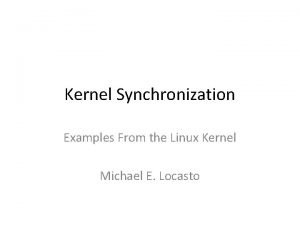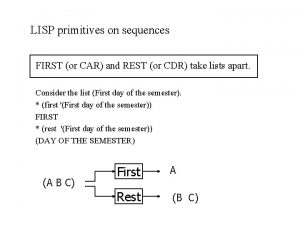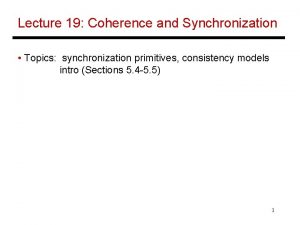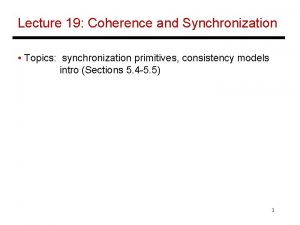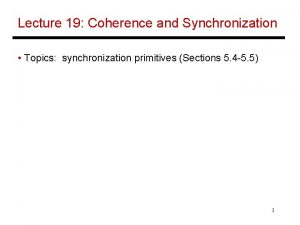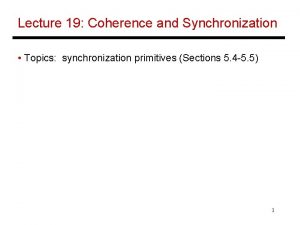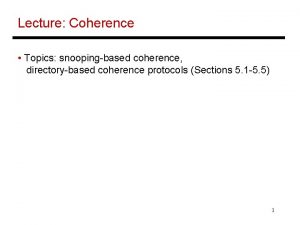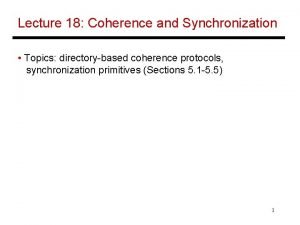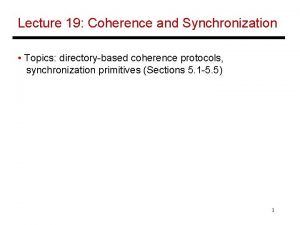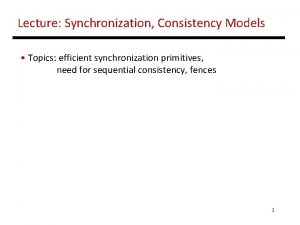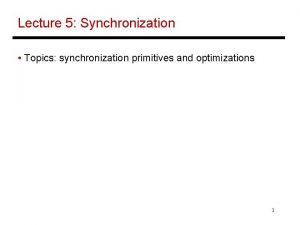Lecture 4 Synchronization Topics evaluating coherence synchronization primitives
















- Slides: 16

Lecture 4: Synchronization • Topics: evaluating coherence, synchronization primitives 1

Example MSI • P 1: Rd • P 1: Wr • P 2: Rd • P 2: Wr P 1 MESI Dragon MSI P 2 MESI Dragon X X X X Total transfers: 2

Evaluating Coherence Protocols • There is no substitute for detailed simulation – high communication need not imply poor performance if the communication is off the critical path – for example, an update protocol almost always consumes more bandwidth, but can often yield better performance • An easy (though, not entirely reliable) metric – simulate cache accesses and compute state transitions – each state transition corresponds to a fixed amount of interconnect traffic 3

State Transitions To From NP I E S M NP 0 0 1. 25 0. 96 1. 68 I 0. 64 0 0 1. 87 0. 002 E 0. 20 0 14. 0 0. 02 1. 00 S 0. 42 2. 5 0 134. 7 2. 24 M 2. 63 0. 002 0 2. 3 843. 6 I E S State transitions per 1000 data memory references for Ocean To From NP NP -- -- Bus. Rd. X I -- -- Bus. Rd. X E -- -- -- S -- -- Not possible -- Bus. Upgr M Bus. WB Not possible Bus. WB M -- Bus actions for each state transition 4

Cache Misses • Coherence misses: cache misses caused by sharing of data blocks – true (two different processes access the same word) and false (processes access different words in the same cache line) • False coherence misses are zero if the block size equals the word size • An upgrade from S to M is a new type of “cache miss” as it generates (inexpensive) bus traffic 5

Block Size • For most programs, a larger block size increases the number of false coherence misses, but significantly reduces most other types of misses (because of locality) – a very large block size will finally increase conflict misses • Large block sizes usually result in high bandwidth needs in spite of the lower miss rate • Alleviating false sharing drawbacks of a large block size: Ø maintain state information at a finer granularity (in other words, prefetch multiple blocks on a miss) Ø delay write invalidations Ø reorganize data structures and decomposition 6

Update-Invalidate Trade-Offs • The best performing protocol is a function of sharing patterns – are the sharers likely to read the newly updated value? Examples: locks, barriers, diff • Each variable in the program has a different sharing pattern – what can we do? • Implement both protocols in hardware – let the programmer/hw select the protocol for each page/block • For example: in the Dragon update protocol, maintain a counter for each block – an access sets the counter to MAX, while an update decrements it – if the counter reaches 0, the block is evicted 7

Synchronization • The simplest hardware primitive that greatly facilitates synchronization implementations (locks, barriers, etc. ) is an atomic read-modify-write • Atomic exchange: swap contents of register and memory • Special case of atomic exchange: test & set: transfer memory location into register and write 1 into memory • lock: t&s register, location bnz register, lock CS st location, #0 8

Improving Lock Algorithms • The basic lock implementation is inefficient because the waiting process is constantly attempting writes heavy invalidate traffic • Test & Set with exponential back-off: if you fail again, double your wait time and try again • Test & Set: read the value, if it has not changed, don’t bother doing the test&set – heavy bus traffic only when the lock is released • Different implementations trade-off one of these lock properties: latency, traffic, scalability, storage, fairness 9

Load-Linked and Store Conditional • LL-SC is an implementation of atomic read-modify-write with very high flexibility • LL: read a value and update a table indicating you have read this address, then perform any amount of computation • SC: attempt to store a result into the same memory location, the store will succeed only if the table indicates that no other process attempted a store since the local LL • SC implementations may not generate bus traffic if the SC fails – hence, more efficient than test&set 10

Load-Linked and Store Conditional lockit: LL R 2, 0(R 1) ; load linked, generates no coherence traffic BNEZ R 2, lockit ; not available, keep spinning DADDUI R 2, R 0, #1 ; put value 1 in R 2 SC R 2, 0(R 1) ; store-conditional succeeds if no one ; updated the lock since the last LL BEQZ R 2, lockit ; confirm that SC succeeded, else keep trying 11

Further Reducing Bandwidth Needs • Even with LL-SC, heavy traffic is generated on a lock release and there are no fairness guarantees • Ticket lock: every arriving process atomically picks up a ticket and increments the ticket counter (with an LL-SC), the process then keeps checking the now-serving variable to see if its turn has arrived, after finishing its turn it increments the now-serving variable – is this really better than the LL-SC implementation? • Array-Based lock: instead of using a “now-serving” variable, use a “now-serving” array and each process waits on a different variable – fair, low latency, low bandwidth, high scalability, but higher storage 12

Barriers • Barriers require each process to execute a lock and unlock to increment the counter and then spin on a shared variable • If multiple barriers use the same variable, deadlock can arise because some process may not have left the earlier barrier – sense-reversing barriers can solve this problem • A tree can be employed to reduce contention for the lock and shared variable • When one process issues a read request, other processes can snoop and update their invalid entries 13

Barrier Implementation LOCK(bar. lock); if (bar. counter == 0) bar. flag = 0; mycount = bar. counter++; UNLOCK(bar. lock); if (mycount == p) { bar. counter = 0; bar. flag = 1; } else while (bar. flag == 0) { }; 14

Sense-Reversing Barrier Implementation local_sense = !(local_sense); LOCK(bar. lock); mycount = bar. counter++; UNLOCK(bar. lock); if (mycount == p) { bar. counter = 0; bar. flag = local_sense; } else { while (bar. flag != local_sense) { }; } 15

Title • Bullet 16
 Synchronization primitives c#
Synchronization primitives c# Kernel synchronization in linux
Kernel synchronization in linux C++ synchronization primitives
C++ synchronization primitives 01:640:244 lecture notes - lecture 15: plat, idah, farad
01:640:244 lecture notes - lecture 15: plat, idah, farad Glut primitives
Glut primitives Data mining primitives languages and system architecture
Data mining primitives languages and system architecture Bundled attributes in computer graphics ppt
Bundled attributes in computer graphics ppt Lisp primitives
Lisp primitives Hanspeter pfister
Hanspeter pfister Application of computer graphics ppt
Application of computer graphics ppt Dérivée composée
Dérivée composée Output primitives
Output primitives Attributes of output primitives
Attributes of output primitives Gl primitives
Gl primitives Pronombres personales fuertes
Pronombres personales fuertes Specialized input device
Specialized input device équations primitives atmosphériques
équations primitives atmosphériques

